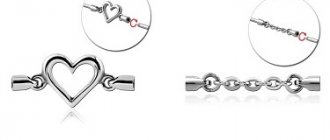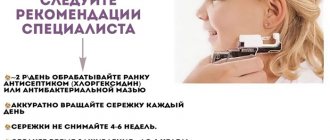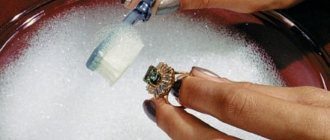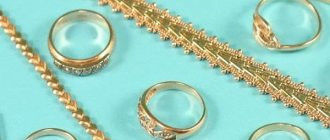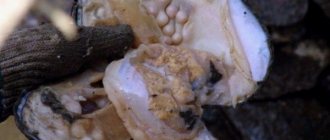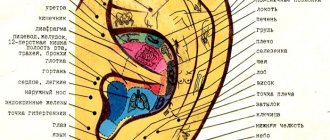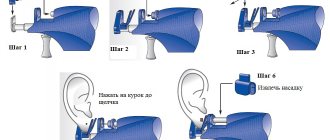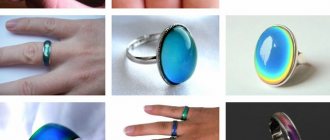Like all types of manipulations associated with violating the integrity of the skin and tissue, piercing can be painful. People with a low pain threshold and sensitive to pain often ask friends if it hurts to have their ears pierced before going to the salon. Most of those who have already undergone the procedure answer “it doesn’t hurt”, “not very much”. Indeed, there are relatively few nerve endings in the lobe, because The basis of soft tissue is cartilage. Piercing the skin with a needle takes a few moments, and usually a person feels a momentary discomfort, which is more associated with the crunching of cartilage tissue than with pain.
But it all also depends on the method of performing the piercing, as well as the tools used and the skill of the performer. Today, almost everyone has it done in a salon where they use special guns that make holes in one second. But sometimes there are people who like to do it “the old fashioned way” at home using an ordinary medical needle, or even a thick darning needle up to 1.5 cm thick.
Why does it hurt and how painful can it be?
Discomfort during the procedure depends on your pain threshold and the location of the puncture . Some salons offer anesthesia to reduce pain to zero, but we do not recommend doing it unless necessary , because the anesthesia injection is quite painful and is comparable to the puncture itself.
To make the puncture less painful, craftsmen use special laser-sharpened hollow needles. They allow the procedure to be carried out as painlessly as possible.
Professional piercers never use guns for piercing, because they push tissue under high pressure, which results in a lacerated wound. Also, pistols cannot be sterilized in a static machine due to the presence of plastic parts in it.
Does it hurt to pierce your ears with a gun?
This is not to say that during the procedure there are no unpleasant sensations at all, they exist and can be rated 3 out of 10. Some say that a loud shot near the ear creates more fear.
In modern realities, a piercing gun is the main way to pierce the ears, because for business it is a goldmine:
- No need to learn piercing
- Cheap
- Fast
Although it is not painful, the whole picture is spoiled by the decoration, which leaves behind a lacerated wound, and this is a direct path to a keloid or, even worse, to a granuloma.
The only good news is that cases of such jewelry being rejected are rare.
Such carnations are made of stainless steel, and for primary decoration it is customary to use titanium or bioplastic , which are highly biocompatible
Children under 3 years of age
Mothers love to pierce the ears of unconscious children, as it is believed that the baby will not remember this unpleasant pain. Also, when the child grows up, he will not remember how his mother helped treat his ears so that they would heal faster.
Not everything is so pessimistic, because the child is almost not in pain and it all goes away in a matter of moments. If you know how to care for it and assume that the jewelry is relatively normal, then you can use this method because the earlobes heal relatively well.
The perception of pain depends on the age and personality of the baby, and what is important is whether you can quickly distract the child if he starts crying, and he will cry
Another unpleasant detail of all this is that the baby may be strenuously reaching for the pier with his hands for the first three days, and if we take into account his weak immunity, it is generally sad that he may get sick.
Where is the best place for a beginner to get their first puncture?
Minimal discomfort comes from piercing the eyebrows and lobe , which heal without any problems. It is a little more painful to pierce Helix and Conch, but they look more interesting. If you are very afraid and worried, you can always consult with a master and ask him all your questions. Perhaps the master will suggest you start with the simplest puncture so that you understand the healing process, and then move on to a more complex puncture.
Is it painful to pierce your ears with a needle and catheter?
It’s worth saying right away that the catheter is a little more painful because its diameter is larger than the piercing needle. During the puncture, the difference in sensations is small, but during work they have to make unnecessary movements, which is why the whole thing is delayed and becomes uncomfortable.
In general, the catheter is not for ear piercing; it is good to pierce an eyebrow, and then only if there is no normal piercing needle. The level of pain from the needle is somewhere around 3.5 out of 10, and from the catheter there is more discomfort, which spoils the sensation of the operation.
Adults from 6 years old
This is already the age when there is an understanding of what it means to endure pain. I would like to note that children are ready to do this for the sake of earrings, and if they are also beautiful, they will drag you to the salon. If the child is able to tolerate it, then the procedure must be carried out according to all the rules.
If you want to do this at home, you can buy everything you need (except antiseptics) on AliExpress:
- Primary decoration must be made of titanium or bioplastic
- The future earring that you will wear on an ongoing basis is needed in order to navigate what diameter of the needle we will need
- Clamp and gloves
- Miramistin and chlorhexidine, as well as the ability to breed physical. solution
- Knowing how to sterilize jewelry
Your child should be more comfortable at home than in a salon, which means he can’t hold back from hellish pain. In fact, piercing the lobes is not difficult and the pain is tolerable.
In the video you can see that everything goes without any pressure, which means the actions are uncertain and the longer it takes, the more painful and unpleasant it becomes.
A second time
Here the psychological factor plays a big role and not the desire to experience those unpleasant sensations again. In any case, you will have to pull yourself together and get over it. Of course, this is not all pleasant, but it’s not all bad either, pull yourself together.
Painkillers for piercings
A frequent client request is to take pain relief before piercing in order to completely avoid pain during the piercing, but good salons will refuse you for several reasons:
External anesthesia does not have the desired effect and only affects the skin, without working on the cartilage; it will relieve you of pain only at the beginning of the puncture, so there will still be pain.
If you give a painkiller injection, it will most likely be more painful than the puncture itself (this is especially true for cartilage).
The master may advise you to take a pain reliever for several days after piercing, for example, Nimesil (in powder form), it relieves pain and swelling well after the procedure.
How long do your ears hurt after a piercing?
Mostly about three days and almost complete healing in three weeks if you take care of it regularly. It is important not to just rinse with miramistin or chlorhexidine, but to alternate rinsing with saline solution. Since these antiseptics destroy not only harmful bacteria but also beneficial ones, and physical. The solution does not kill the good ones, but it does not allow the bad ones to live either.
Also, Miramistin, unlike chlorhexidine, can stimulate wounds and they heal faster. Rinsing the perforation reduces discomfort and speeds up healing. So don't forget about prevention.
What to do after getting your ear pierced
Here are a few simple but important rules:
- Do not remove the pierced earring for at least 6 weeks.
- Wash the piercing site daily with warm water and soap. Do not use Body Piercing/KidsHealth For Teens to disinfect with hydrogen peroxide or rubbing alcohol.
- After rinsing your ear, very carefully twist the earring in the hole. This is necessary so that the skin around the stud does not grow too tightly.
- During the day, try to touch your ear as little as possible to avoid infection. Also avoid swimming in open water and public pools.
- Monitor the condition of the puncture. Immediately after the piercing, your earlobe may appear red and slightly swollen. But this goes away in 1–2 days. If the problems last longer or you observe new signs indicating an infection (pain, itching, redness, increased skin temperature in the piercing area), try a salt compress Ear Piercing: What You Should To Know / WebMD. Dissolve half a teaspoon of salt in a cup of warm water, soak a cotton swab in the liquid and apply it to your ear. After a few minutes, pat dry and apply over-the-counter antibiotic ointment. Monitor the condition for a couple more days. If it does not improve, consult a therapist.
- After 6 weeks or more, remove the earring. Wash your ear with warm water and soap and install the decoration you like.
Cartilage Piercing Care
TIPS FOR CARE OF EAR CARTILAGE PIERINGS (HELIX, CONCH, LOW HELIX,TRAGUS, ANTITRAGUS, DAITH, FORWARD HELIX, ROOK)
Where is it more painful to pierce your ear?
The pain experienced during ear piercing will be the same, regardless of what type of piercing is chosen. As for the level of pain, there is no need to be afraid of a puncture in this area, because if the master knows what he is doing, it will take no more than a second. The client will not even have time to understand what happened and will hardly feel any pain.
What is the healing time?
Complete healing usually takes about 6-12 months.
What jewelry is suitable for a fresh piercing?
The type of decoration depends on where the puncture is made. If it is “flat”, “tragus” or “helix”, then you need to install a labret; it can be replaced with a ring only after primary healing. But if the “dais” is pierced, then the ring is chosen as the primary decoration. An extended rod is installed in the “industrial” rod. In "ruuk" - banana.
How long will the swelling last and how severe will it be?
The swelling is worst in the first couple of days. The ear may almost double in size, but this reaction is normal and you should not be afraid of it. The swelling will last no more than one to two weeks.
Do I need to scroll the decoration?
Scrolling the jewelry is strictly prohibited, since irritation of a fresh wound can increase the healing time, as well as provoke increased swelling, pain, and even contribute to infection.
After what time can I wash my hair?
It is best to avoid contact with water for several days after the piercing. Then you can take a shower, but it is important to prevent the wound from steaming, as well as soap and other products from getting into it.
Will it be possible to wear headphones?
If a puncture was chosen on the outer arch of the cartilage, for example, “Helix”, you can wear in-ear headphones; if “Days”, then over-ear ones. But in other cases you will have to stop wearing it.
How to care?
A puncture is a wound, so it is necessary, firstly, not to interfere with the recovery process, and secondly, to keep the wound clean. Avoid contact with street dust and do not touch with dirty hands. Following proper care will help avoid infection and other problems.
For care you will need miramistin or saline solution, as well as a patch.
You need to pour the saline solution into a suitable container and completely immerse the solution in it for three minutes, then carefully remove the soaked discharge with a cotton swab. The remaining solution must be washed off with water.
It is necessary to moisten a cotton pad or napkin with Miramistin, and then apply it to the puncture site for one or two minutes to disinfect.
How will the puncture affect everyday life?
It is important to promote the recovery process - maintain proper nutrition and healthy sleep, drink plenty of water, and maintain immunity. All this will help the body direct all its strength to the proper healing of the wound.
From the moment of puncture until the tenth day, you need to wash the wound twice a day, and also apply lotions with miramistin every time dust and dirt gets on it. However, using miramistin more than two or three times a day is not recommended. The wound will need to be sealed on both sides with an absorbent plaster - first constantly, then only before going to bed and when walking outside. At home and at work (if the room is clean), you don’t have to seal the puncture, but be sure to avoid contact with any irritants.
From the eleventh to the fortieth day, treatment is carried out once a day. It is permissible to replace the saline solution with a weakly concentrated soap solution; there is no need to seal the puncture, but you still need to exclude contact with external irritants.
After the fortieth day, it will be necessary to replace the jewelry (downsize), since the primary healing is over, the swelling has subsided, and an unsuitable barbell or labret can dangle and injure the puncture. It is important to remember that you should not wear jewelry made from unknown alloys and materials - this can again cause redness and swelling. Treatment should be carried out several times a week.
What should you not do with a puncture?
1. You cannot tamper with or change the decoration in any way. To speed up healing, you need to disturb the puncture as little as possible. In addition, if you take it out before a few months, it will lead to swelling, and it will not be possible to put it back in place without help.
2. You cannot use hydrogen peroxide, as well as alcohol-containing products, and especially pure alcohol, any ointments, homemade or purchased herbal remedies. All this can cause a chemical burn, irritation, allergies or infection.
3. It is necessary to prevent cosmetics and care products from getting into the wound so as not to provoke allergies or inflammation.
4. Limit (or better yet, eliminate) the consumption of alcohol, caffeine and medications (blood thinners), as well as smoking. Blood flow to the wound and deterioration of the immune system significantly slow down recovery.
5. Avoid visiting swimming pools, baths and saunas for at least a month, and a solarium for two weeks.
Is it necessary to inspect a puncture?
If severe swelling appears in the first ten days, causing the jewelry to dig into the skin, then you need to visit a specialist for replacement.
After the fortieth day, if the piercing does not cause problems and the swelling has subsided, then you need to replace the jewelry.
How can you tell if a puncture is wrong?
1. The jewelry digs into the skin - this is due to severe swelling. In this case, it is necessary to replace the decoration. 2. If the puncture hurts after six months, this happens if the wound is injured, as well as in case of improper care. This does not pose any danger, it is better to consult with a specialist. 3. If a growth appears near the puncture, this indicates the appearance of a keloid scar. It is necessary to consult with a specialist - keloids are not harmful to health, but they can spoil the aesthetic appearance and therefore require removal.
Care Tips
1. It is better to avoid any contact with the puncture as much as possible. Touching leads to microdamage to the canal, which slows down healing and increases pain. 2. It would be ideal to completely give up smoking and alcohol. Due to their consumption, blood flow worsens and swelling increases, which increases the healing time. 3. It is better to take care of the container for saline solution in advance. It is convenient to use disposable utensils; a sterile glass or ceramic container is also suitable. 4. It is necessary to completely avoid sleeping on the side from which the puncture was made in order to avoid pressure, which means improper healing.
How to prepare for an ear piercing at home
Make sure you have everything you need.
- Sterile latex gloves.
- Ice Cube.
- Hydrogen peroxide or rubbing alcohol solution for disinfection.
- Cotton pads.
- Marker or fountain pen.
- Sterile piercing needle. It can be purchased at a pharmacy or a specialty store that sells cosmetics. The needle should have a diameter slightly larger than the stud of the jewelry you plan to wear.
- Ear piercing kit is optional. It usually includes two sterile earrings loaded into a special medical hole punch (cartridge).
- Stud earrings to wear for the first time after the piercing.
- Puncture support. This could be a rubber eraser, a bar of soap, or a wine cork.
Choose a well-lit place. If you have long hair, tie it in a tight bun or otherwise keep it away from your ears. Then apply an ice cube to the future piercing site for 1-2 minutes. This will help reduce discomfort.
Soak a cotton pad in peroxide or rubbing alcohol solution and thoroughly disinfect your ear. Using a marker or fountain pen, place a dot in the place where the puncture will be.
Photos: @Sofie Bjen / YouTube
Advice: if this is the first puncture, make it strictly in the middle of the lobe or literally 0.5–1 millimeter higher. Then the piercing will be as painless as possible.
Disinfect your earrings in hydrogen peroxide or rubbing alcohol. Open the piercing needle or ear piercing cartridge. Do not touch sterile equipment until you wash your hands with soap and wear latex gloves.
